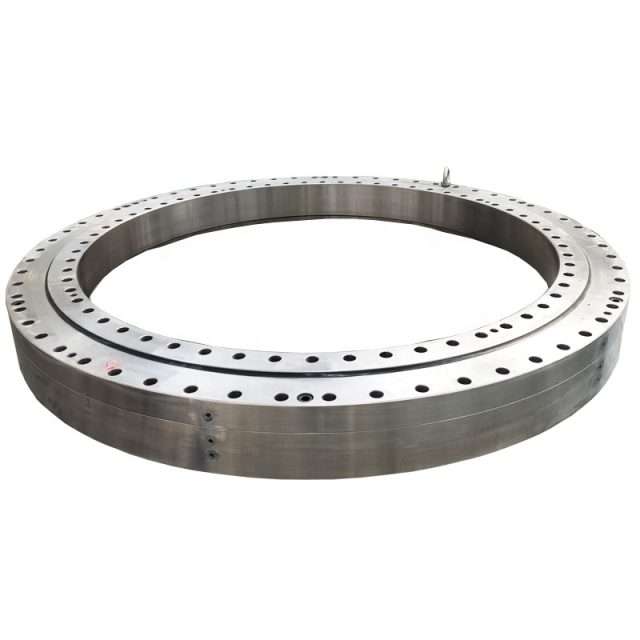slewing gear factory
Table of Contents
1.Selection and Practical Application of Clearance of Precision Slewing Gears
The precision slewing gear can rotate smoothly to obtain an ideal runout value. Generally, when designing and manufacturing, the clearance value will choose small clearance, zero clearance, and negative clearance.
The corresponding clearance value is generally 0 to 0.05. ≤0, -0.05 to -0.01, the corresponding preloads are: no preload, light preload, and heavy preload.
During processing, we can measure the channel size according to the method of measuring the channel size of the slewing bearing, and calculate the clearance value (whether positive or negative) according to the measurement data, and then check the calculated clearance value after the processing is completed.
The positive clearance is directly measured with a dial indicator, and the negative clearance is used to measure the starting torque of the slewing gear. According to the size of the starting torque, the size of the interference of the slewing bearing is judged.
The starting torque is also a must know in the use of the slewing bearing. A value of , which determines the selection of slewing gear reducer and motor.
To measure the starting torque of the slewing bearing, it is necessary to measure the starting force of the slewing bearing first, and a dynamometer is required. Since the maximum starting force occurs at the moment when the slewing gear is about to rotate, a force measurement that can record the maximum value of the measurement is required. meter to measure the driving force of the slewing bearing.
Starting torque=starting force x lever arm, the starting force can be measured with a dynamometer, we generally install a bolt on the outer ring hole of the slewing bearing, and use a dynamometer to measure the starting force of the slewing drive at the bolt, and the distribution of the bolt holes in the outer ring The radius of the circle is the arm, and the starting torque of the slewing bearing is calculated from the starting force and the arm.
For the same slewing gear, the difference in starting torque can reflect the size of the clearance value of the negative clearance slewing bearing. The larger the starting torque, the smaller the clearance value and the greater the preload.
The selection of the clearance value should also consider the situation of the customer’s equipment. The smaller the clearance value of the slewing bearing, the higher the requirements for installation and use.
Due to the small deformation, the small deformation of the slewing bearing can be offset by the clearance when the clearance is large, and the slewing gear can rotate normally after installation, but if it is a small or negative clearance, the slewing gear has no extra clearance to resist the small deformation.
If the slewing bearing is deformed, it will be stuck, rotated poorly, or even stuck, resulting in damage or failure to use.

2.How to improve the tooth machining efficiency of the slewing gear?
The slewing ring bearing is a large bearing that operates at low speed and heavy load. Usually the inner ring or outer ring has teeth. It is used to connect large components that require relative rotation. It is widely used in automated industrial machinery, construction machinery, wind power equipment, port machinery and other fields. ,
In the whole cycle of the slewing bearing from the forging to the finished product until it is sent to the user, the tooth processing process takes up a lot of time, and the length of the delivery time depends to a large extent on the processing efficiency of the slewing gear teeth.
In recent years, due to the country’s strong investment in infrastructure, new energy equipment and other fields, the market demand for slewing ring bearings has also increased sharply, and the supply is often in short supply.
On the other hand, there are many domestic manufacturers of slewing ring bearings. Minimizing costs on the premise of quality is the key for enterprises to stand out in the fierce market competition.
Gear machining is the longest time-consuming process in the production process of slewing bearings, and it has always been one of the most important factors restricting the production efficiency of slewing bearings. The traditional slewing gear tooth machining usually has two methods: gear shaping and gear hobbing.
In order to adapt to the improvement of processing accuracy and production efficiency requirements, gear hobbing and gear shaping technology are constantly developing in the direction of full numerical control, high speed, high precision, and intelligence, but the processing efficiency has not yet reached the ideal state, especially the processing of internal teeth. Only the gear shaper can be used, the cutting amount of each feed is small, and the processing efficiency is low.
In recent years, a machining method of CNC high-speed tooth milling has been gradually promoted in the slewing gear industry. There are two types of internal teeth and external teeth, which are processed by the profiling principle.
with high processing efficiency and large feed amount, suitable for large diameter, large Modular slewing bearing processing, especially internal gear processing, is 5-8 times more efficient than traditional gear shaping, which greatly shortens the production cycle of slewing bearings.
Gear milling, gear hobbing, and gear shaping have their own advantages and disadvantages in terms of processing efficiency and equipment cost. In the case of sufficient market demand, the efficiency of gear milling is better than that of gear hobbing and gear shaping, and the cost of gear milling is also lower than that of gear hobbing and gear shaping.

